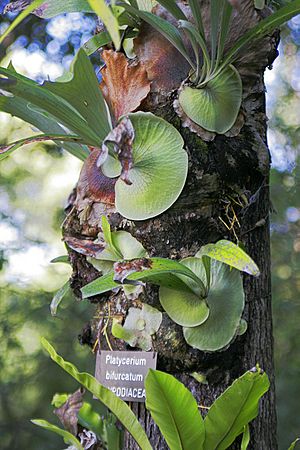Platycerium facts for kids
Platycerium is a group of about 18 different kinds of ferns. These ferns are often called staghorn or elkhorn ferns because their leaves, called fronds, look like the antlers of a deer or elk! These special ferns are epiphytic, which means they grow on other plants, like trees, or even on rocks, but they don't harm them. You can find them naturally in warm, tropical places and some cooler areas in South America, Africa, Southeast Asia, Australia, and New Guinea.
Quick facts for kids Platycerium |
|
|---|---|
 |
|
| Platycerium bifurcatum from the Australian National Botanical Gardens, Canberra | |
| Scientific classification |
|
| Kingdom: | Plantae |
| Clade: | Tracheophytes |
| Class: | Polypodiopsida |
| Order: | Polypodiales |
| Suborder: | Polypodiineae |
| Family: | Polypodiaceae |
| Subfamily: | Platycerioideae |
| Genus: | Platycerium Desv. |
| Species | |
|
|
Contents
What Do Staghorn Ferns Look Like?
Adult Platycerium plants have roots that grow in clumps from a short stem called a rhizome. This rhizome grows two main types of fronds (leaves).
Basal Fronds: The Shield Leaves
One type is called the basal fronds. These fronds are flat, shield-shaped, and don't produce spores. They grow tightly against the tree or rock where the fern lives. Their job is to protect the fern's roots from getting damaged or drying out.
In some Platycerium types, the top edge of these fronds forms a cup-like shape. This cup helps catch falling leaves, twigs, and water from the forest. This collected material then breaks down and provides food for the fern.
Fertile Fronds: The Antler Leaves
The other type of frond is called the fertile fronds. These are the ones that look like deer antlers! They stick out or hang down from the rhizome. On the underside of these fronds, you'll find tiny brown spots or patches. These patches are called sori, and they contain the fern's spores.
The spores are usually found on the tips of the antler-like lobes or in the dips between them.
How They Grow and Spread
Some Platycerium species grow as single plants, with just one rhizome. Others can form large groups or colonies. This happens when their rhizomes branch out, or when new rhizomes grow from the tips of their roots.
If the conditions are just right, the tiny spores can land on nearby trees and start to grow into new ferns all by themselves.
Growing Staghorn Ferns at Home
Two types of staghorn ferns, Platycerium bifurcatum and Platycerium superbum, are very popular to grow as ornamental plants. People love their unique shapes! You can often see these ferns in gardens, especially in warm, tropical gardens, where they grow on trees or rocks.
How to Make More Ferns
You can grow new staghorn ferns from the tiny spores found on the underside of the fertile fronds. This is a natural way they reproduce.
If you have a large, healthy group of colonial Platycerium, you can also carefully divide it into smaller, separate plants. These new plants can then be attached to a board or tied to a tree. They will eventually attach themselves to their new home.
A fully grown staghorn fern can become quite large, sometimes growing more than 3 feet (1 meter) wide!
Gallery
-
Platycerium bifurcatum from the Mendut Temple, Indonesia
-
Platycerium grande from Bukidnon, Philippines
-
Platycerium elephantotis at Kaisaniemi Botanical Garden, Finland
See also
 In Spanish: Helechos cuerno de ciervo para niños
In Spanish: Helechos cuerno de ciervo para niños






